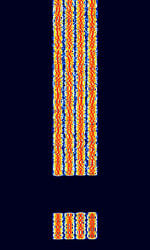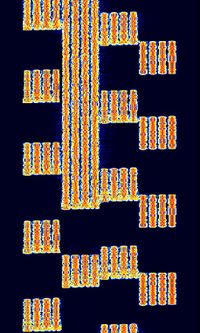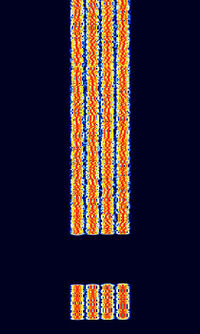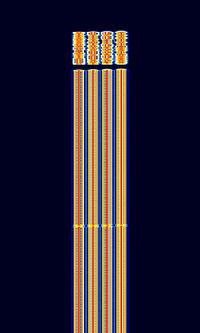CLOVER-II
CLOVER-I | CLOVER-II | CLOVER 2000 | CLOVER 2500
CLOVER-II is the advancement of CLOVER-I, with 4 tone pulses and a max data rate of 750 bpsBits per second (bps). Also known as Q-CLOVER and QUAD-CLOVER. The symbol rate is always 31.25 BdBaud (unit symbol Bd) is the unit for symbol rate or modulation rate in symbols per second.. CLOVER-II was the result of the work by Ray Petit W7GHM, and HAL Communications, including the PCI-4000, the P38, and the DSP-4100. The mode was released in late 1992 on HAL transceivers. The last HAL unit to carry Clover II was the DSP4100. Bosnia and Ireland were major users of Clover II.
CLOVER-II uses 4 125 HzHertz (Hz), unit of frequency, defined as one cycle per second (1 Hz). wide tone-pulse subcarriers that are each offset from the base tone by 8ms, so that every 32ms all four tone pulses transmit their cycle. CLOVER-II uses Phase (PSKPhase-Shift Keying) or Phase-Amplitude (Circular QAMQuadrature Amplitude Modulation) shift keying modulation.
There are 4 500 HzHertz (Hz), unit of frequency, defined as one cycle per second (1 Hz). channels defined for CLOVER-II.
- Channel 1: 750 HzHertz (Hz), unit of frequency, defined as one cycle per second (1 Hz). Center Frequency
- Channel 2: 1250 HzHertz (Hz), unit of frequency, defined as one cycle per second (1 Hz). Center Frequency
- Channel 3: 1750 HzHertz (Hz), unit of frequency, defined as one cycle per second (1 Hz). Center Frequency
- Channel 4: 2250 HzHertz (Hz), unit of frequency, defined as one cycle per second (1 Hz). Center Frequency
Channel 4 is the factory default channel used.
There are 6 main modulation modes.
| Mode | Description | Data Rate | ARQAutomatic Repeat reQuestAutomatic Repeat Query/FECForward Error Correction Support |
|---|---|---|---|
| 16P4A | 16-Phase 4-Amplitude Modulation (64-QAMQuadrature Amplitude Modulation) | 750 bpsBits per second (bps) Max | ARQAutomatic Repeat reQuestAutomatic Repeat Query & FECForward Error Correction |
| 8P2A | 8-Phase 2-Amplitude Modulation (16-QAMQuadrature Amplitude Modulation) | 500 bpsBits per second (bps) Max | ARQAutomatic Repeat reQuestAutomatic Repeat Query & FECForward Error Correction |
| 8PSM | 8 Phase Shift-Keying Modulation (8-PSK8-Phase Phase-Shift Keying (3 bits per symbol)) | 375 bpsBits per second (bps) Max | ARQAutomatic Repeat reQuestAutomatic Repeat Query & FECForward Error Correction |
| QPSM | Quadrature Phase-Shift Keying (QPSKQuadrature Phase-Shift Keying (2 bits per symbol)) | 250 bpsBits per second (bps) Max | ARQAutomatic Repeat reQuestAutomatic Repeat Query & FECForward Error Correction |
| BPSM | BPSKBinary Phase-Shift Keying (1 bit per symbol) Binary Phase-Shift Keying (QPSKQuadrature Phase-Shift Keying (2 bits per symbol)) | 125 bpsBits per second (bps) Max | ARQAutomatic Repeat reQuestAutomatic Repeat Query & FECForward Error Correction |
| 2DPSM | BPSKBinary Phase-Shift Keying (1 bit per symbol) with 2-Channel Redundancy | 62.5 bpsBits per second (bps) Max | FECForward Error Correction |
Samples[edit]
Channels[edit]
| Channel 1 | Channel 2 |
|---|---|
| Channel 3 | Channel 4 |
|---|---|
| All Channels (Simulated) |
|---|
Additional CLOVER-II Samples[edit]
| Start of TXTransmit | End of TXTransmit |
|---|---|
Various Other Samples[edit]
Decoding Software[edit]
Additional Links[edit]
- HF Digital "Tower of Babel"
- shoc Database: Clover-II
- WAVECOM Database: Clover-II
- ARRL CLOVER
- CLOVER Article by K9GWT, 1996
- CLOVER-II: A TECHNICAL OVERVIEW, 1991
- VQ9ZZ Clover Information





